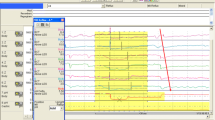Abstract
If 24-hour esophageal pH monitoring is to be a useful diagnostic tool, it must reliably discriminate gastroesophageal reflux patients despite daily variations in distal esophageal acid exposure. To address this issue, we studied 53 subjects (14 healthy normals, 14 esophagitis patients, and 25 patients with atypical symptoms) with two ambulatory pH tests performed within 10 days of each other. Intrasubject reproducibility of 12 pH parameters to discriminate the presence of abnormal acid reflux was determined. As a group, the parameters of percent time with pH<4 (total, upright, recumbent) were most reproducible (80%). Therefore, a subject was defined as having gastroesophageal reflux disease if at least one of these three values were abnormal. Intrasubject reproducibility for the diagnosis of reflux disease was 89% for the entire sample. Among subsets, the reproducibility was 93% for the normals and esophagitis patients and 84% for the atypical symptom patients. Total percent time with pH<4 was the single most discriminate pH parameter (85%) and nearly equaled that of the three combined parameters (89%). The intrasubject variability of this parameter was determined by the mean ±2sd of the relative differences between the two test results for all 53 subjects. Total percent time with pH<4 may vary between tests by a factor of 3.2-fold or less (218% higher to 69% lower). We conclude: (1) ambulatory 24-hr esophageal monitoring is a reproducible test for the diagnosis of gastroesophageal reflux disease; and (2) the large intrastudy variability in 24-hr total acid exposure may limit this test's usefulness as a measurement of therapeutic improvement.
Similar content being viewed by others
References
Nebel, OT, Fornes MF, Castell DO: Symptomatic gastroesophageal reflux: incidence and precipitating factors. Am J Dig Dis 21:953–956, 1976
Richter JE, Castell DO: Gastroesophageal reflux: Pathogenesis, diagnosis and therapy. Ann Intern Med 97:93–103, 1982
Johnson LF: New concepts and methods in the study and treatment of gastroesophageal reflux disease. Med Clin North Am 65:1195–1222, 1981
Hollander F: What is pH? Explanation of various measures of acidity employed in gastroesophageal reflux. Gastroenterology 4:497–508, 1944
Tuttle SG, Ruffln F, Bettarella A: The physiology of heartburn. Ann Intern Med 55:292–300, 1961
Wallin L, Madsen T: Twelve-hour simultaneous registration of acid reflux and peristaltic activity in the esophagus: A study in normal subjects. Scand J Gastroenterol 14:561–566, 1979
Johnson LF, DeMeester TR: Twenty-four pH monitoring of the distal esophagus: a quantitative measure of gastroesophageal reflux. Am J Gastroenterol 62:325–332, 1974
Ward BW, Wu WC, Richter JE, Lui KW, Castell DO: Ambulatory 24-hour esophageal pH monitoring. Technology searching for a clinical application. J Clin Gastroenterol 8(Suppl 1):59–67, 1986
Winer BJ: Statistical Principles in Experimental Design, 2nd ed. New York, McGraw-Hill, 1971
Barnett V, Lewis T: Outlines in Statistical Data. New York, John Wiley & Sons, 1978
Boesby S: Continuous oesophageal pH recording and acid-clearing test. A study of reproducibility. Scand J Gastroenterol 12:245–247, 1977
Lichter I: Measurement of gastro-oesophageal acid reflux: Its significance in hiatus hernia. Br J Surg 61:253–258, 1974
Perino LE, Goff JS: Reproducibility of 24-hour ambulatory esophageal pH monitoring in normal subjects. Gastroenterology 90:1583A, 1986
Bontempo I, Corazziari E, Tosoni M, Ercole A: Reproducibility of esophageal pH-metric measurements. Gastroenterology 88:1331A, 1985
Johnson LF, DeMeester TR: Development of the 24-hour intraesophageal pH monitoring composite scoring system. J Clin Gastroenterol 8(Suppl l):52–58, 1986
Schindlbeck NE, Heinrich C, Konig A, Dendorfer A, Pace F, Muller-Lissner SA: Optimal thresholds, sensitivity, and specificity of long-term pH-metry for the detection of gastroesophageal reflux disease. Gastroenterology 93:85–90, 1987
Johnsson F, Joelsson B, Isberg PE: Ambulatory 24-hour intraesophageal pH monitoring in the diagnosis of gastroesophageal reflux disease. Gut 28:1145–1150, 1987
Dodds WJ, Hogan WJ, Helm JF, Dent J: Pathogenesis of reflux esophagitis. Gastroenterology 81:376–394, 1981
Yuan Y, Murphy DW, Wu WC, Castell DO: Does the esophageal pH probe miss events of acid gastroesophageal reflux? Assessment in human subjects. Am J Gastroenterol 82:210, 1987 (abstract)
Castell DO: The lower esophageal sphincter: physiologic and clinical aspects. Ann Intern Med 83:390–401, 1975
Lachin JM: Introduction to sample size determinations and power analysis for clinical trials. Controlled Clin Trials 2:93–113, 1981
Author information
Authors and Affiliations
Additional information
Supported, in part, by Public Health Services Grant AM 34200-01A1 from NIADDIK.
Rights and permissions
About this article
Cite this article
Wiener, G.J., Morgan, T.M., Copper, J.B. et al. Ambulatory 24-hour esophageal pH monitoring. Digest Dis Sci 33, 1127–1133 (1988). https://doi.org/10.1007/BF01535789
Received:
Revised:
Accepted:
Issue Date:
DOI: https://doi.org/10.1007/BF01535789




